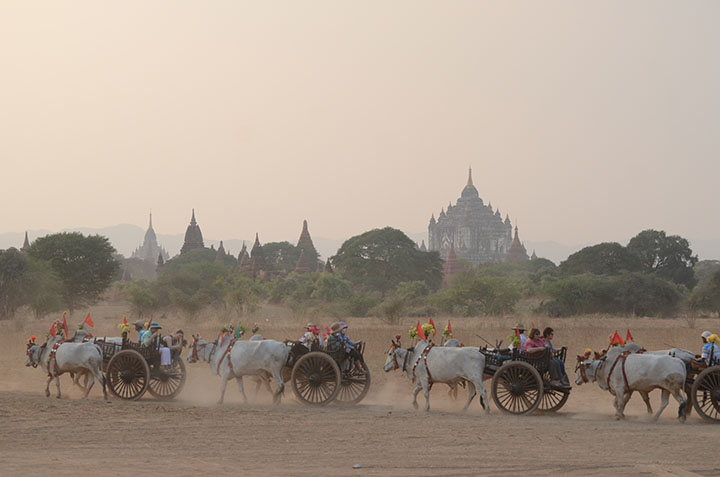Twenty-three years after Myanmar first nominated Bagan, the UNESCO World Heritage Committee is set to decide whether the site will make it into the World Heritage List.
Bagan will be one of the 36 nominations that will be considered during the committee’s 43rd session in Baku, Azerbaijan, from 30 June to 10 July.
The Ministry of Culture and Religious Affairs has been working with domestic and foreign experts since 2013 to formulate a management system to put Bagan on the World Heritage List.
Bagan has an exceptionally good chance of entering the list due to its unique cultural value and architecture, boasting over three to four thousand structures in one place.
If Bagan is included in UNESCO’s World Heritage List, it will contribute to strengthening our national integrity, besides promoting tourism. It will also allow Myanmar to get the necessary technological assistance to preserve Bagan, in line with international standards.
Tourists mainly come to Myanmar to visit Bagan and upgrading it from a national heritage to a world heritage ranking will boost tourism significantly. This, in turn, will create more jobs for local residents and promote businesses related to tourism.
The authorities have been seeking Bagan’s inclusion on the World Heritage List since 1996, but their applications have been dismissed on grounds of not meeting certain standards or requirements.
But, the Department of Archaeology and National Museum applied again in 2018, after ensuring that all the requirements were met.

Background
Considered one of the most important archaeological and monument sites in Asia, the city of Bagan was the centre of an economic, socio-political and cultural network in an extensive Buddhist empire that had its peak between 11th and 13th centuries CE. On the Ayeyarwady River in the central dry zone of Myanmar, Bagan includes more than 3,500 surviving stupas, temples, monasteries, fortifications and other monuments, according to the official inventory of the Department of Archaeology and National Museums, set in an extensive landscape that also features archaeological deposits and the remains of an ancient water-management system.
Bagan is a rich ensemble of monumental Buddhist architecture and a continuing testimony to the living tradition of Buddhist merit-making. The religious devotion and wealth of this early Buddhist empire are expressed through the remarkable scale and density of the architecture and continuing religious activities, which have survived for centuries and influenced the region.
Process of World Heritage inscription
Myanmar first submitted Bagan for the World Heritage List in 1996 after the completion of an inventory of monuments and a zoning management plan with the support of UNESCO. Due to the high risk of inappropriate commercial development in the protected area, the requirements for inscription were not fulfilled initially. Myanmar authorities decided to try again more than 20 years later, within the framework of an overall renewed commitment towards the implementation of the 1972 World Heritage Convention.
For the last six years, UNESCO has supported Myanmar’s effort to nominate Bagan through a series of capacity-building activities. Maps and the inventory of monuments have been updated and site conservation has been strengthened in line with international standards. In particular, a comprehensive set of guidelines for the conservation of Bagan has been developed, including conservation of mural paintings, in-depth condition assessment for bricks monument. After the earthquake that heavily damaged the monuments of Bagan in August 2016, special attention was given to the development of a strategy which addresses assessment of damages, post-earthquake stabilization, and post-disaster rehabilitation.
A detailed management plan for Bagan was also produced to enhance the legal and institutional framework for protecting the site, especially to address pressures from uncontrolled development in a protected area that is still an imminent threat.
World Heritage Nomination of Bagan
In February 2018, the Myanmar Government submitted the completed nomination to the UNESCO World Heritage Centre and later received feedback from the International Council of Monuments and Sites (ICOMOS), the professional and scientific advisory body for cultural heritage nominations.
The final decision on the nomination is expected on 5 or 6 July when the review of the inscription on the World Heritage List will be carried out by the 21 members of the World Heritage Committee.
If the application is successful, Bagan will become Myanmar’s second entry on the World Heritage List. UNESCO added the Pyu Ancient Cities – Hanlin, Beikthano and Sri Ksetra – to the list in 2014.
Significance
To be included on UNESCO’s World Heritage List, sites must be of Outstanding Universal Value, meaning that their cultural significance is so exceptional that it transcends national boundaries and are of common importance for present and future generations of all humanity. As such, the permanent protection of this heritage is of the highest importance to the international community as a whole. A comprehensive protection and management plan is crucial to make sure that if the site is included in the list, the proper mechanisms – legal, institutional, managerial, etc – are in place so that the site will be preserved and passed on to future generations.
While the cultural and historical significance of Bagan is beyond doubt, the inscription in the World Heritage List will also bind all the involved parties to a shared responsibility for the safeguarding of the site. The inscription would also bring additional benefits by raising the visibility of Bagan, galvanizing technical and financial assistance, supporting the sustainable development of the area, and helping to maintain and nourish the site to thrive.
Three ancient Pyu cities were entered into the UNESCO World Heritage List in 2014.
If Bagan makes it into the list, authorities say they will campaign for including MraukU Region into the list in 2020.-GNLM



